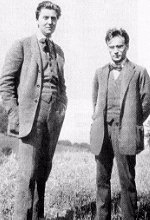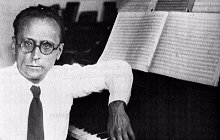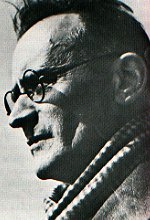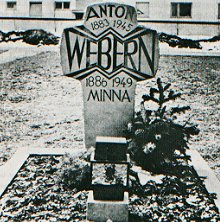Anton Webern (1883-1945) - biography
2
1924 - Dodecaphony

Alban Berg
and Anton von Webern
Together with Alban Berg, Webern adopted also already early the „twelve-tone
technique" developed by Schönberg. He use it for the first time in
„Drei Volkstexte" op 17 for voice, clarinet, bass clarinet and violin (1924).
Unlike Schönberg, Webern used the potentialities of the dodecaphony
for the motif, rhythmical and dynamic arrangement of his works, particularly
in the „Variations for orchestra" op 30 (1940). Webern said about the technique
in this work to develop musical events from a few motif cells: „Everything
that occurs in the piece is based on the two ideas given with the first
and second measure in contrabass and oboe."
The most important dodecaphonic compositions by Webern are the
„Symphony for a small orchestra" op 21 (1928), „Quartet for violin, clarinet,
tenor saxophone and piano" op 22 (1930), the „String trio" op 20 (1927)
and the „Concerto for nine instruments" op 24 (1934) dedicated to Arnold
Schönberg on the occasion of his 60th birthday.

Mödling, (1930)
1933 - Inner emigration

Anton von Webern (1940)
In 1933, Arnold Schönberg emigrated to America, Alban Berg
died in 1935. Anton von Webern got rapidly into a personal isolation,
aggravated by the political troubles (civil war in 1934 and corporative
state government under Dollfuß and Schuschnig) and financial difficulties
as well.
In this time, Webern met the Jone family. He was a close friend
of Hildegard Jone. The composer used her poems as texts for his three cantatas
(1st cantata „Das Augenlicht" op 26 of 1935, 2nd and 3rd cantata
op 29 and 31 of 1940 and 1943) as well as for „Drei Gesänge
aus 'Viae inviae'" op 23 (1934). After Austria's „anschluss" into the „German
Reich" in 1938, the National Socialist rulers banned Webern's performances
and publications. In the following inner emigration, he developed in ideas
numerous references between the serial technique and religious mysticism,
which find also expression in the already mentioned cantatas after texts
by Hildegard Jone.
In spring 1945, he fled from Vienna to Mittersill, where
the family of his daughter lived. Here, he fell a victim to a fatal mistake
on September 15th 1945. An American soldier took him for a smuggler
and shot him dead, as Webern smoked a cigarette outside the house after
closing time.

|